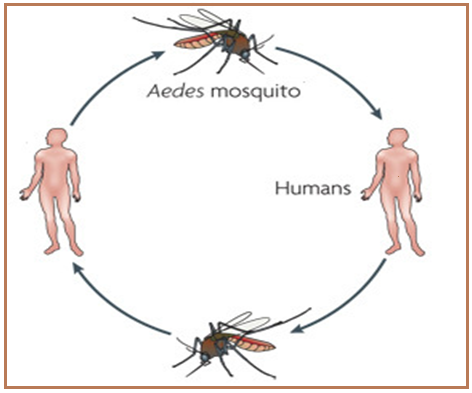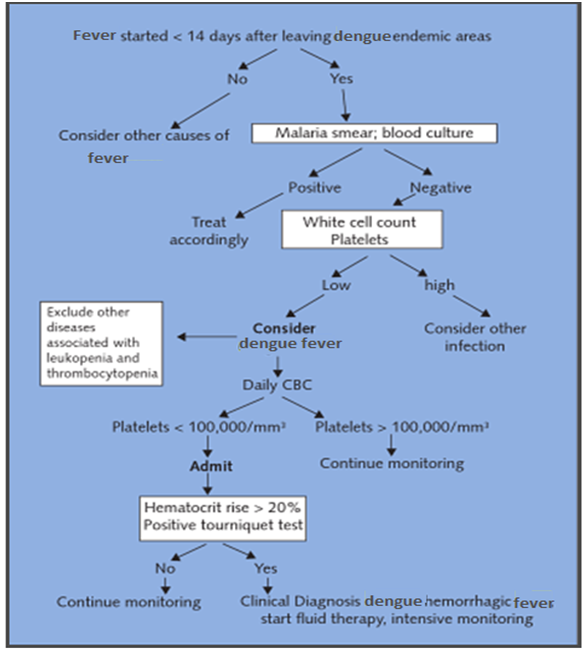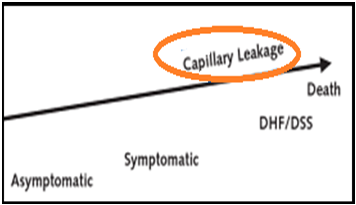Dengue: A serious health problem in India
Dengue is a worldwide health concern and recently it broke out in Indian terrain. News reports indicated that in Delhi, condition is worse due to this fatal disease. Dengue is an acute viral infection with potential deadly complications. Dengue Fever is a viral infection that's carried by mosquitoes and causes fever, body pains, joint pain, and rash. It spreads by the tiger mosquito (AedesAegypti), which has black and yellow stripes and typically bites in the early morning or at dawn.
Dengue virus belongs to family Flaviviridae, which has four serotypes that istransmitted by the bite of infected Aedes mosquitoes.Aedesaegypti is a small, dark mosquito that can be recognised by the white bands on its legs and a silver-white pattern of scales on its body that resembles like an ancient Greek musical instrument called lyre. These mosquitoes are found in tropical and subtropical regions all over the world, mainly between the latitudes of 35°N and 35°S where the winter temperature is not colder than 10°C.
Dendue mosquito, Aedesaegypti causesdifferent types of ailment from mild asymptomatic illness to severe incurable dengue haemorrhagic fever/dengue shock syndrome (DHF/DSS). It is estimated in reports that approximately 2.5 billion people live in dengue-risk provinces with about 100 million new cases each year at global level. Currently, dengue disease presents highly complex pathophysiological, financial and ecologic problems.
Reports signified that in India, the first epidemic of clinical dengue-like illness was recorded in Chennai in 1780 and the first virologically proved epidemic of dengue fever (DF) occurred in Kolkata and Eastern Coast of India in 1963-1964. Since then, team of physicians have treated and defined dengue disease in India, but the scientific studies addressing various problems of dengue disease have been carried out at limited number of centres.
According to the WHO 2009 report, dengue fever is divided into two groups such as Uncomplicated and severe, though the 1997 WHO classification is still widely used. The 1997 classification divided dengue into undistinguishable fever, dengue fever, and dengue haemorrhagic fever.
There are four main characteristic manifestations of dengue illness:
- Continuous high fever lasting 2-7 days
- Haemorrhagic tendency as shown by a positive tourniquet test, petechiae or epistaxis
- Thrombocytopoenia (platelet count < 100×109/l)
- Evidence of plasma leakage manifested by haemoconcentration (an increase in haematocrit 20% above average for age, sex and population), pleural effusion and ascites.
It is estimated in health reports that approximately 390 types dengue infections occur worldwide each year, with about 96 million resulting in illness. Most cases occur in tropical areas of the world, with the greatest risk occurring in:
- The Indian subcontinent
- Southeast Asia
- Southern China
- Taiwan
- The Pacific Islands
- The Caribbean (except Cuba and the Cayman Islands)
- Mexico
- Africa
- Central and South America (except Chile, Paraguay, and Argentina)
Causes: Main cause of dengue fever is through any one of four dengue viruses spread by mosquitoes that increase in and near human lodgings. When a mosquito bites a person infected with a dengue virus, the virus enters into the mosquito. And this infected mosquito then bites another person, the virus enters in that person's bloodstream.
The dengue virus is transmitted through a human-to-mosquito-to-human cycle of transmission. Normally, four days after being bit by an infected Aedesaegypti mosquito, a person will develop viremia, a condition in which there is a high level of the dengue virus in the blood. Viremia stays for roughly five days, but can last as long as twelve days. On the first day of viremia, the person usually do not exhibit symptoms of dengue. Five days after being bitten by the infected mosquito, the person develops symptoms of dengue fever, which can last for a week or longer.
Figure: Dengue transmission

Symptoms of Dengue Fever:
Many people, particularly children and teens, may exhibit no signs or symptoms during a mild case of dengue fever. When symptoms do occur, they usually begin four to 10 days after you are bitten by an infected mosquito. Symptomsmay include
- Sudden, high fever as high as 106 F (41 C)
- Severe headache
- Pain behind the eyes
- Severe joint and muscle pain
- Fatigue
- Nausea
- Vomiting
- Skin rash, which appears two to five days after the onset of fever
- Mild bleeding (such a nose bleed, bleeding gums, or easy bruising)
Most people recover from dengue bite within a week or so. In some cases, symptoms deteriorate and can become life-threatening. Blood vessels often become damaged and dripping. The number of clot-forming cells (platelets) in pateint’s bloodstream drops. This can cause:
- Bleeding from nose and mouth
- Severe abdominal pain
- Persistent vomiting
- Bleeding under the skin, which might look like bruising
- Problems with your lungs, liver and heart
When patients must seek doctor’s advice: When person has recently visited a region in which dengue fever is known to occur and he suddenly develop a fever, it is recommended to visit doctor.
Diagnosing Dengue Fever:
Dengue fever is diagnosed with a blood test and doctors can check for the virus or antibodies to it. If person become sick after traveling to a tropical area, they must inform to doctor. This will allow doctor to evaluate the possibility that symptoms are caused by a dengue infection.
Figure: Clinical diagnosis of dengue in returning travellers (Source: Schwartz, 2009)

The following laboratory tests should also be performed for patients with possible dengue:
- Complete blood count (CBC)
- Metabolic panel
- Serum protein and albumin levels
- Liver panel
- Disseminated intravascular coagulation (DIC) panel
Laboratory diagnosis of dengue fever (Source: Smith, 2005):
| Types of Diagnosis | Advantages and Limitations |
Confirmed Diagnosis
Probable Diagnosis
|
Requires convalescent serum Cross-reactivity to other flaviviruses (Including previous vaccination agaisnt japanese encephalitis and yellowfever), Less than 50% senstive; only early increase Test is not commonly available. Sensitivity ⟩ 90% in the first few days of illnes, rapidly declines and usually ⟨ 10% sensitivity 7 days after onset of symptoms. High Specificity. Test is not commonly available Less than 50% sensitivity 89-99%, specifivity 92%, commercially available. Negative early in disease, only positive from 4-5 days after onset of symptoms. Cross-reactivity to other flaviviruses (Including previous vaccination against Japanese encephalitis and yellowfever.) |
Treatment for Dengue Fever:
There is no precise medicine to treat dengue infection. Patient experiencing dengue fever, may use pain relievers with acetaminophen with the recommendations of doctor and avoid medicines with aspirin, which could worsen bleeding. Such patients are recommended to take rest, drink plenty of fluids, and visit doctor regularly. In case of high fever within 24 hours, and they feel worse, then they should get to a hospital immediately to be checked for complications.
If patient is suffering from severe dengue fever, he may need:
- Supportive care in a hospital
- Intravenous (IV) fluid and electrolyte replacement
- Blood pressure monitoring
- Transfusion to replace blood loss
Risk factors:
Factors that are at greater risk of developing dengue fever or a more severe form of the disease include:
Complications of Dengue:
If condition is critical due to dengue fever, it can damage the lungs, liver or heart. Blood pressure can drop to dangerous levels, causing shock and, in some cases, death.
Figure: Clinical spectrum of dengue fever (Source: 2009)

Preventing Dengue Fever:
In medical science, there is no vaccine to prevent dengue fever. Therefore, people must take preventive measuressuch as to avoid bites by infected mosquitoes, particularly if they are living in or traveling to a tropical area.
Protection from this deadly disease: Medical experts recommended following ways to protect from this disease:
- Stay away from densely populated residential areas, if possible.
- Use mosquito repellents, even indoors.
- When outdoors, wear long-sleeved shirts and long pants tucked into socks.
- When indoors, use air conditioning if available.
- Make sure window and door screens are secure and free of holes. If sleeping areas are not screened or air conditioned, use mosquito nets.
- If person show symptoms of dengue, immediately contact to doctor.
To reduce the mosquito population, get rid of places where mosquitoes can breed. These include old tires, cans, or flower pots that collect rain. Frequently change the water in outdoor bird baths and pets’ water dishes.
If someone in home gets dengue fever, it is important to carefully watch about efforts to protect self and other family members from mosquitoes. Mosquitoes that bite the infected family member could spread the infection to others in home.
Indian Currenet scenario of Dengue Fever:
In present year of 2015, in Indian capital of New Delhi, local authority reports showed that there are more than 477 cases of dengue fever in August, the highest number since 2010, bringing the total number of cases this year to more than 530.The All India Institute of Medical Sciences (AIIMS) and the National Centre for Disease Control (NCDC) have planned to start serological tests to classifypredominant strains of the virus this year.
According to the results, New Delhi reported over 6,000 cases of mosquito-borne diseases in 2010, 885 of them in August. "The number of dengue fever cases has increased in this year due to the increase in rainfall. This has created favourable conditions for mosquitoes to breed.
According to medical experts, though there are more number of cases, symptoms of the disease seem to be relatively mild this year. Most of the patients are suffering from fever, muscle and joint pains. This condition cannot be termed as an epidemic. It is due to seasonal changes.
In short, it can be said that dengue is a mosquito-borne viral infection. The person who got infection may show symptoms of flu-like illness, and occasionally develops into deadly complication which is termed as severe dengue. It causes fever, nausea, vomiting and muscle and joint aches. The global occurrence of dengue has grown radically in recent years.
Currently most of the countries are at risk of this lethal disease. Dengue is found in tropical and sub-tropical climates around the world, mostly in urban and semi-urban areas. Severe dengue is main cause of serious disease and even death among children in some Asian and Latin American countries.
There is no specific treatment for dengue/ severe dengue, but if it is diagnosed early and access to proper medical care, it can be controlled. Dengue fever is a possibly fatal mosquito-borne disease which mainly affects people in tropical and subtropical areas every summer. Dengue prevention and control specially depends on effective vector control measures.
Articles on Health
- Causes and remedy for dark circles in females

- Harmful impact of mobile phone on unborn baby

- Maternal health care tips

- Rheumatoid Arthritis is Most Widespread in Female
- Periodontal ailment during Pregnancy
- Anemia is prevalent in Women
- Effect of Cell phone tower radiation on human health

- Current health scenario india
- Government health policies india
- Medical facilities india
- Hospital infrastructure india
- Shortage of Medical Professionals in India
- Quality standards indian hospitals
- Indian states health statistics
- Medical expenses india
- Hospitals in Ahmedabad
- Hospitals in Bangalore
- Hospitals in Chennai
- Hospitals in Cochin
- Hospitals in Delhi
- Hospitals in Hyderabad
- Hospitals in Kolkata
- Hospitals in Mumbai
- Hospitals in Pune
- Hospitals in Coimbatore
- Hospitals in Kochi
- Orthopaedics Hospitals in India
- Diabetology Hospitals in India
- Cardiology Hospitals in India
- Infertility Hospitals in India
- Neurology Hospitals in India
- Paediatrics Hospitals in India
- Nephrology Hospitals in India
- Oncology Hospitals in India
- Antiaging foods to improve skin

- Tips for Maintaining healthy bones
- Guidelines for preventing heart disease
- Tips to reduce eye strain while working on computer
- Mental health problems among elderly people
- Health problem of piles

- Health advices for air travel

- Dealing with Allergies
- Tips for Eyes Care
- Care for Crystal Clear Skin
- Tips For Healthy Hair
- Healthy Living is The Absolute Measure of Happiness
- Let Fragrance Rule Your Summer
- Most common vestibular disorder

- Osteoporosis Risk Factors
- Dengue

- Endocrine disorder

- Causes of liver damage
- Dry eye syndrome
- Kidney Stones
- Conjunctivitis: Irritating eye disease
- Anxiety Disorder
- Causes of Brain Damage
- Hepititis B
- Knowledge of Osteoarthritis
- Mental Illness
- Back Pain
- Sugar Addiction
- Diet Control Plans
- General Motors Diet Plan
- No Carbohydrate Diet
- One day Diet Plans
- Seven day diet Plans
- Vegetarian Diet
- Food for Health
- Genetically Modified Foods
- Healing Effects Of Fruits
- Vegetables That Heal
- Healing Effects Of Spices and Herbs
- Test your Stress Level
- Mantras for Relaxation & Stress free life
- Take walk For a healthy body and mind
- Squint is frequently observed in Children
- Consult-Doctor
- Free Handy Health Advice